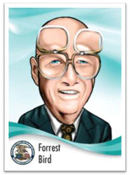|
Bird Innovator
The Bird Innovator was an American four-engined executive amphibious airplane modified from a Consolidated PBY Catalina by the Bird Corporation. Design and development During the late 1960s Forrest Bird and his Bird Corporation developed a conversion for the PBY Catalina to improve performance. The Catalina was modified by adding two 340 hp (254 kW) Lycoming GSO-480-B2D6 engines positioned outboard of the original Pratt & Whitney radials to increase range and performance. (These engines and cowlings had originally been installed on the McKinnon four engine Grumman Goose. When they were removed by McKinnon to convert the Goose to twin turboprop power, they were purchased by Bird for his PBY Innovator conversion. Engineering for the Innovator conversion was performed by Spectro engineering of Los Angeles). The wing attach fittings were strengthened and fuel capacity increased by adding fuel bladders to the outer wing panels. The engineer's controls were previously moved t ... [...More Info...] [...Related Items...] OR: [Wikipedia] [Google] [Baidu] |
Bird Corporation
Forrest Morton Bird (June 9, 1921 – August 2, 2015) was an American aviator, inventor, and biomedical engineer. He is best known for having created some of the first reliable mass-produced mechanical ventilators for acute and chronic cardiopulmonary care. Biography Bird was born in Stoughton, Massachusetts. Bird became a pilot at an early age due to his fathers encouragement. By age 14, he flew his first solo fight. By age 16 he was working to obtain multiple major pilot certifications. Bird enlisted with the United States Army Air Corps, and entered active duty in 1941 as a technical air training officer due to his advanced qualifications. This rank, combined with the onset of World War II, gave him the opportunity to pilot almost every aircraft in service, including early jet aircraft and helicopters. The newest models of aircraft were capable of exceeding altitudes at which humans can breathe, even with 100% oxygen supplementation, introducing the risk of hypoxia. Bird ... [...More Info...] [...Related Items...] OR: [Wikipedia] [Google] [Baidu] |
List Of PBY Catalina Survivors
PBY Catalina Survivors identifies Catalinas on display, and includes aircraft designations, status, serial numbers, locations and additional information. The Consolidated PBY Catalina was a twin-engined American flying boat of the 1930s and 1940s, designed by Consolidated Aircraft Co. Several variants were built at five US and Canadian manufacturing plants. Surviving aircraft These complete examples of Catalinas have been preserved or restored to various levels including markings, nose art, original or representative paint schemes, and are on display at museums or at military bases, or are active aircraft potentially viewable at air events. By default, 5-digit numeric serials known as Bureau Numbers (BuNo) are as issued by the US Navy Bureau of Aeronautics (BuAer), presented here without the imaginary "BuNo" prefix. 4-digit serials in the form 9xxx, and 5-digit serials in the form 1xxxx are as issued to Royal Canadian Air Force The Royal Canadian Air Force (RCAF; french: Avi ... [...More Info...] [...Related Items...] OR: [Wikipedia] [Google] [Baidu] |
Parasol-wing Aircraft
A monoplane is a fixed-wing aircraft configuration with a single mainplane, in contrast to a biplane or other types of multiplanes, which have multiple planes. A monoplane has inherently the highest efficiency and lowest drag of any wing configuration and is the simplest to build. However, during the early years of flight, these advantages were offset by its greater weight and lower manoeuvrability, making it relatively rare until the 1930s. Since then, the monoplane has been the most common form for a fixed-wing aircraft. Characteristics Support and weight The inherent efficiency of the monoplane is best achieved in the cantilever wing, which carries all structural forces internally. However, to fly at practical speeds the wing must be made thin, which requires a heavy structure to make it strong and stiff enough. External bracing can be used to improve structural efficiency, reducing weight and cost. For a wing of a given size, the weight reduction allows it to fly slower a ... [...More Info...] [...Related Items...] OR: [Wikipedia] [Google] [Baidu] |
Bird Corporation Aircraft
Birds are a group of warm-blooded vertebrates constituting the class Aves (), characterised by feathers, toothless beaked jaws, the laying of hard-shelled eggs, a high metabolic rate, a four-chambered heart, and a strong yet lightweight skeleton. Birds live worldwide and range in size from the bee hummingbird to the ostrich. There are about ten thousand living species, more than half of which are passerine, or "perching" birds. Birds have whose development varies according to species; the only known groups without wings are the extinct moa and elephant birds. Wings, which are modified forelimbs, gave birds the ability to fly, although further evolution has led to the loss of flight in some birds, including ratites, penguins, and diverse endemic island species. The digestive and respiratory systems of birds are also uniquely adapted for flight. Some bird species of aquatic environments, particularly seabirds and some waterbirds, have further evolved for swimming. Birds ... [...More Info...] [...Related Items...] OR: [Wikipedia] [Google] [Baidu] |


.jpg)